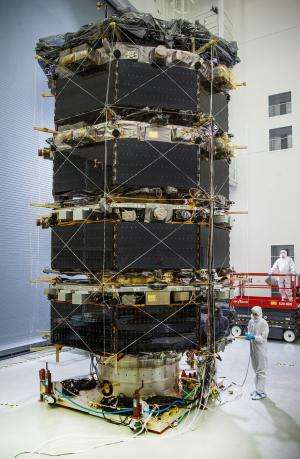NASA's MMS observatories stacked for testing

(Phys.org) —Engineers at NASA's Goddard Space Flight Center in Greenbelt, Md., accomplished another first. Using a large overhead crane, they mated two Magnetospheric Multiscale, or MMS, observatories – also called mini-stacks—at a time, to construct a full four-stack of observatories.
Next, the MMS four-stack will be carefully transported from their Goddard cleanroom to a special vibration facility—housed within the same immense integration and testing facility—where they will be secured to a large shaking table and subjected to vibration tests. These tests help to ensure the structural integrity of the stacked spacecraft prior to shipment to NASA's Kennedy Space Center, Fla.
The vibration tests determine whether the four MMS spacecraft can withstand the extreme vibration and dynamic loads they will experience inside the fairing of the Atlas V launch vehicle on launch day. It's during the first moments after lift-off that the spacecraft is exposed to the most stress.
The MMS mission consists of four spacecraft outfitted with identical instruments. The mission will fly through near-Earth space to study how the sun and Earth's magnetic fields connect and disconnect, an explosive process that can accelerate particles through space to nearly the speed of light. This process is called magnetic reconnection and occurs throughout all space.
MMS is a Solar Terrestrial Probes Program, or STP, mission within NASA's Heliophysics Division. STP program missions improve our understanding of fundamental physical processes in the space environment from the sun to Earth, to other planets, and to the extremes of the solar system boundary. Goddard is building the MMS spacecraft and the Fast Plasma Instrument for NASA's Science Mission Directorate in Washington.
Provided by NASA





















